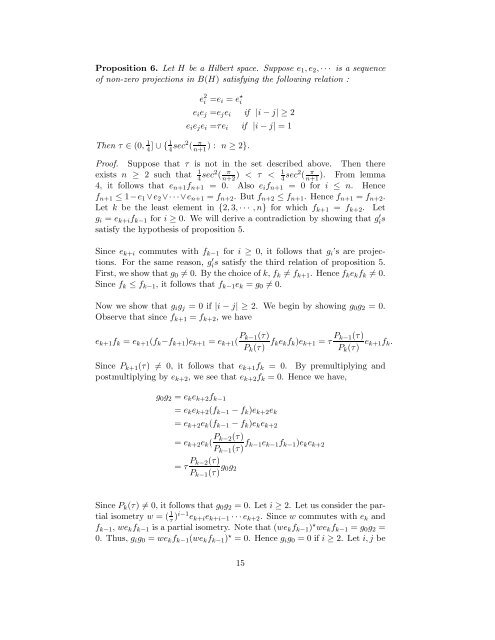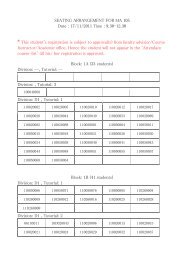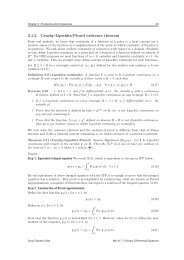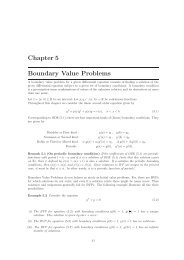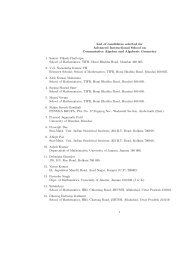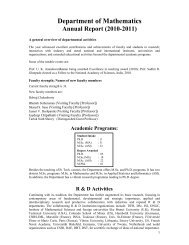the Masters' Thesis of S. Sundar
the Masters' Thesis of S. Sundar
the Masters' Thesis of S. Sundar
Create successful ePaper yourself
Turn your PDF publications into a flip-book with our unique Google optimized e-Paper software.
Proposition 6. Let H be a Hilbert space. Suppose e1,e2, · · · is a sequence<br />
<strong>of</strong> non-zero projections in B(H) satisfying <strong>the</strong> following relation :<br />
e 2 i =ei = e ⋆ i<br />
eiej =ejei if |i − j| ≥ 2<br />
eiejei =τei if |i − j| = 1<br />
Then τ ∈ (0, 1<br />
4 ] ∪ {1<br />
4sec2 ( π<br />
n+1 ) : n ≥ 2}.<br />
Pro<strong>of</strong>. Suppose that τ is not in <strong>the</strong> set described above. Then <strong>the</strong>re<br />
exists n ≥ 2 such that 1<br />
4sec2 ( π<br />
1<br />
n+2 ) < τ < 4sec2 ( π<br />
n+1 ). From lemma<br />
4, it follows that en+1fn+1 = 0. Also eifn+1 = 0 for i ≤ n. Hence<br />
fn+1 ≤ 1−e1 ∨e2 ∨· · ·∨en+1 = fn+2. But fn+2 ≤ fn+1. Hence fn+1 = fn+2.<br />
Let k be <strong>the</strong> least element in {2,3, · · · ,n} for which fk+1 = fk+2. Let<br />
gi = ek+ifk−1 for i ≥ 0. We will derive a contradiction by showing that g ′ is satisfy <strong>the</strong> hypo<strong>the</strong>sis <strong>of</strong> proposition 5.<br />
Since ek+i commutes with fk−1 for i ≥ 0, it follows that gi’s are projections.<br />
For <strong>the</strong> same reason, g ′ is satisfy <strong>the</strong> third relation <strong>of</strong> proposition 5.<br />
First, we show that g0 �= 0. By <strong>the</strong> choice <strong>of</strong> k, fk �= fk+1. Hence fkekfk �= 0.<br />
Since fk ≤ fk−1, it follows that fk−1ek = g0 �= 0.<br />
Now we show that gigj = 0 if |i − j| ≥ 2. We begin by showing g0g2 = 0.<br />
Observe that since fk+1 = fk+2, we have<br />
ek+1fk = ek+1(fk−fk+1)ek+1 = ek+1( Pk−1(τ)<br />
Pk(τ) fkekfk)ek+1 = τ Pk−1(τ)<br />
Pk(τ) ek+1fk.<br />
Since Pk+1(τ) �= 0, it follows that ek+1fk = 0. By premultiplying and<br />
postmultiplying by ek+2, we see that ek+2fk = 0. Hence we have,<br />
g0g2 = ekek+2fk−1<br />
= ekek+2(fk−1 − fk)ek+2ek<br />
= ek+2ek(fk−1 − fk)ekek+2<br />
= ek+2ek( Pk−2(τ)<br />
Pk−1(τ) fk−1ek−1fk−1)ekek+2<br />
= τ Pk−2(τ)<br />
Pk−1(τ) g0g2<br />
Since Pk(τ) �= 0, it follows that g0g2 = 0. Let i ≥ 2. Let us consider <strong>the</strong> par-<br />
tial isometry w = ( 1<br />
τ )i−1 ek+iek+i−1 · · · ek+2. Since w commutes with ek and<br />
fk−1, wekfk−1 is a partial isometry. Note that (wekfk−1) ⋆ wekfk−1 = g0g2 =<br />
0. Thus, gig0 = wekfk−1(wekfk−1) ⋆ = 0. Hence gig0 = 0 if i ≥ 2. Let i,j be<br />
15


